The Xiaomi Mi 11 Ultra Review: Big and Fast, but Inefficient
by Andrei Frumusanu on July 20, 2021 9:00 AM EST- Posted in
- Mobile
- Smartphones
- Xiaomi
- Mi 11 Ultra
System Performance - Extremely Snappy
When we reviewed the Mi 11 earlier in the year, that should have generally covered the performance evaluation for the Mi 11 Ultra as well as both devices are on the exact same hardware platform and also feature the same OS. However, since the Mi 11’s release, Xiaomi has released and pushed out an update to MIUI in the form of version 12.5 which has promised considerable improvements in terms of performance and responsiveness of the system.
On top of that, this spring, UL has released a new PCMark suite version 3.0 – while the workloads here are generally the same as that of version 2.0, the new application is built using the newest build tools and is now 64-bit capable. In past generation devices, the performance difference between 32-bit and 64-bit was relatively small, however recent generation Cortex CPU cores from Arm have had more stark feature discrepancies in regards to performance of AArch64 vs AArch32, favouring the former newer ISA as next year we expect 32-bit SoCs to be partially deprecated, and see a full shift to 64-bit only in 2023 devices. The new benchmark version here adapts to the shifting landscape, and more accurately represents the performance of today’s devices.
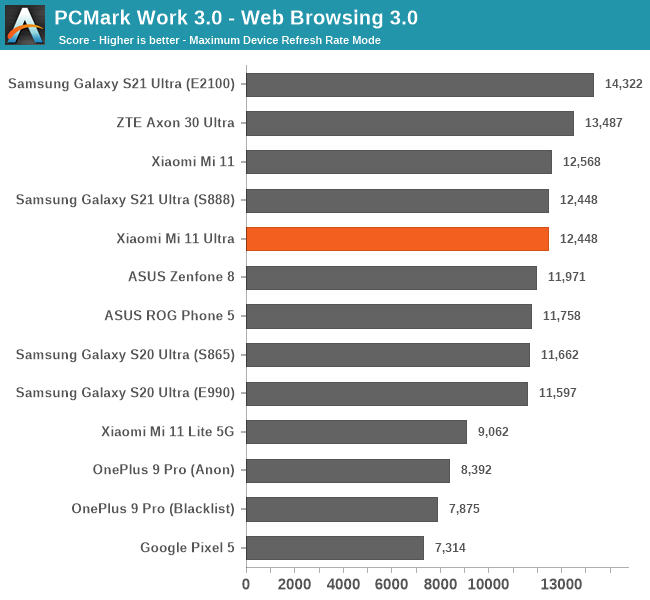
The web-browsing workload is sensible to frame-rate of the display, as well as how aggressive the scheduler and DVFS of the chips are. The Mi 11 Ultra here generally performs excellently as is in line with the Mi 11 and the Snapdragon 888 S21 Ultra. There’s a few devices which are a bit more aggressive but this also comes at a cost of more battery drain.
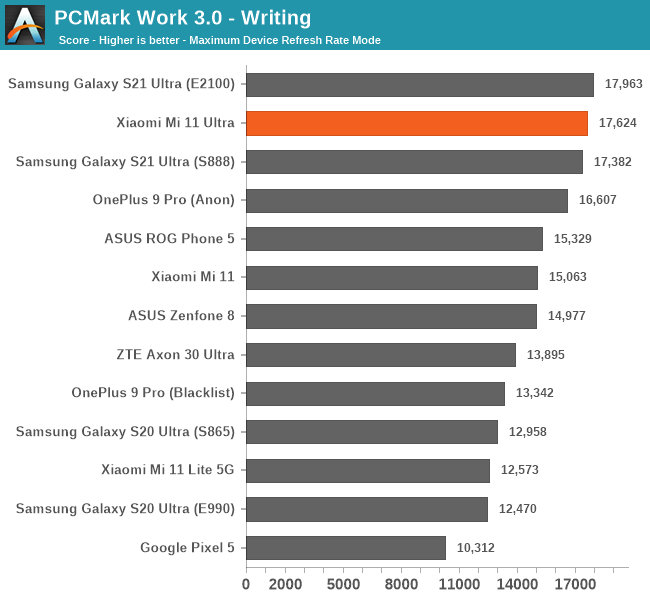
In the writing subtest which is one of the most representative for general device responsiveness in every-day usage, the Mi 11 Ultra is extremely well performing and just notches out the S21 Ultra – only the Exynos here is slightly even more aggressive. There’s quite a bit of a difference to the Mi 11 which is to be noted.
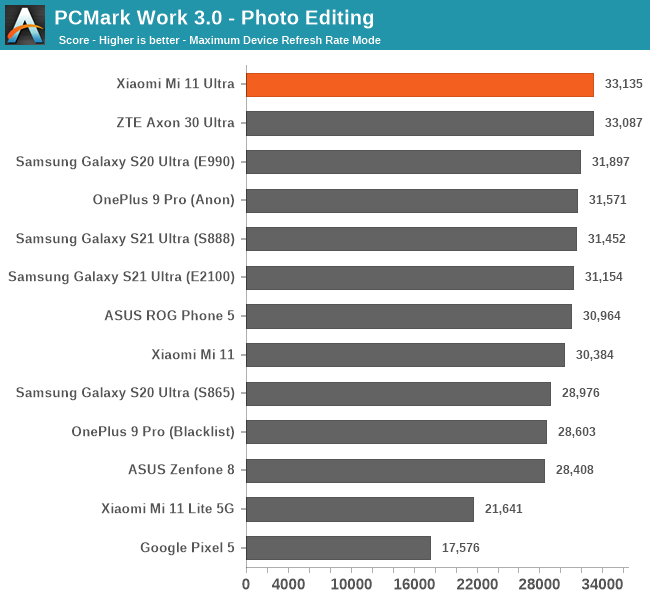
Photo editing workloads generally fall back to the GPU via RenderScript, and we see the Mi 11 Ultra take the top spot by a smidge of a performance advantage over the Axon 30 Ultra.
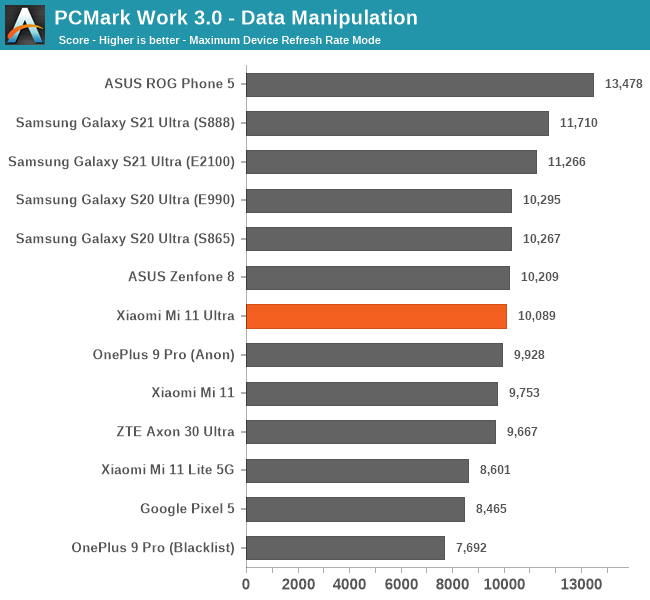
The data manipulation test is mostly single-threaded bound and here it depends on how the OS schedules things on the UI. The Mi 11 Ultra falls in the middle of the pack.
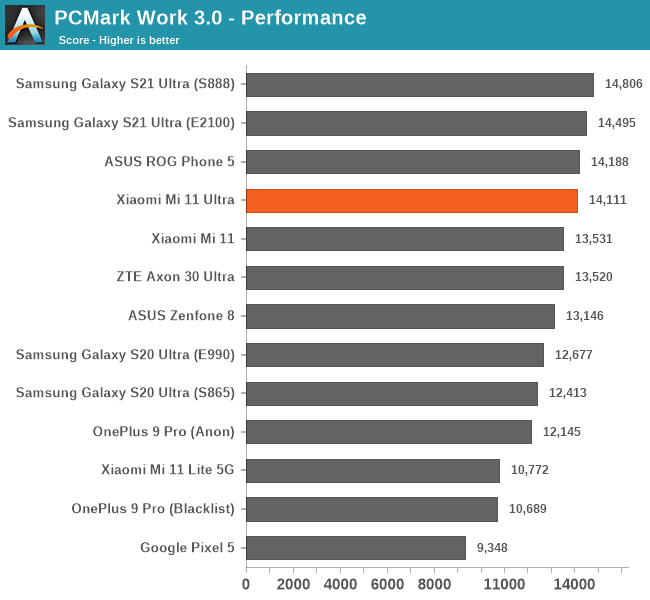
Overall, the Mi 11 Ultra falls in amongst the top performing flagship phones in 2021, which is unsurprising and very much what we expected.
Web Browser Performance
Alongside a new PCMark version, this year we’ve also hit the reset button on our browser benchmark results due to the introduction of 64-bit web browsers. For the same reasons aforementioned in PCMark, the new AArch64-only software packages for browsers mean that the new results can take better advantage of microarchitectural features of CPUs which were previously not used in the 32-bit variants, augmenting the scores for newer generation devices, making the scores incompatible. We’ve retested a range of recent flagship devices:
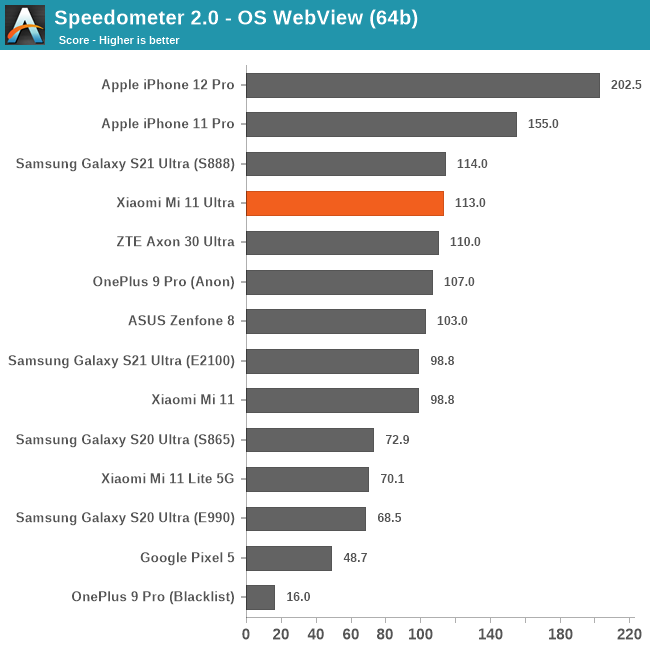
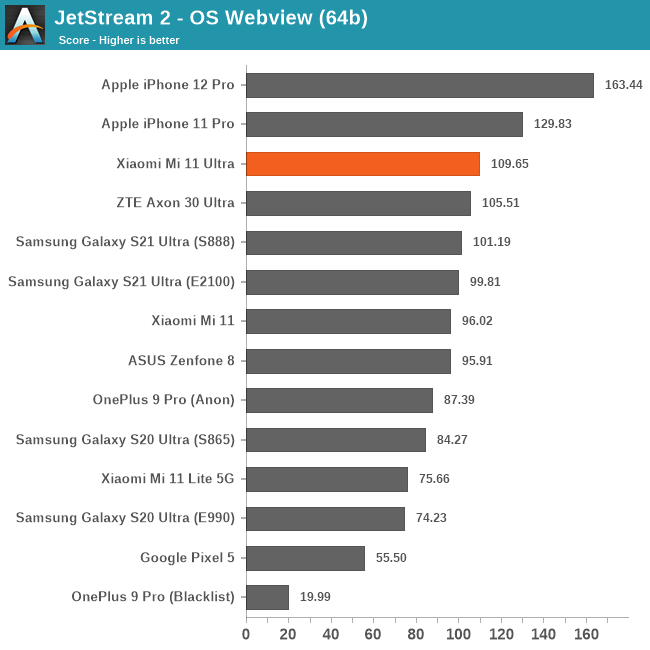
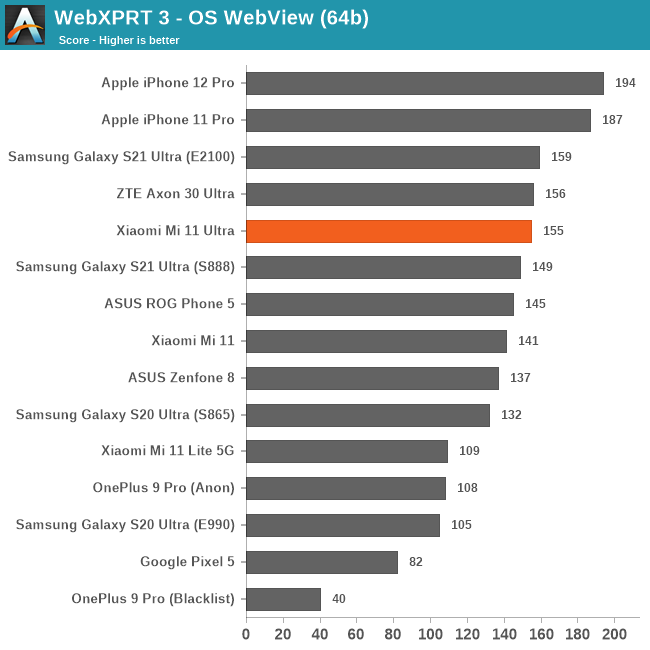
In all the web tests, the Mi 11 Ultra also performed admirably, as one of the top-performing Snapdragon 888 devices on the market.
Subjectively, the Mi 11 Ultra is absolutely one of the fastest and most responsive devices on the market right now. When Xiaomi had pushed the new MIUI 12.5 version to the Mi 11 back a few months ago, I immediately noticed the vast improvement in overall UI performance, actually making me rank the Mi 11 and consequently also the Mi 11 Ultra as amongst the fastest Android phones out there.
The only real negatives I would have about Xiaomi’s software stack today is that the devices’ 60Hz mode is still seemingly extremely unoptimized compared to their 120Hz modes. I’m not exactly sure what is happening here, but it feels as if Xiaomi is not properly scaling or altering various scheduler settings to 60Hz down from 120Hz, or I also suspect that Xiaomi is tying the touch sample rate to the refresh rate, as I notice vastly increased delay in the 60Hz mode, something which doesn’t happen or is nearly as noticeable on Samsung’s 60Hz mode on their 120Hz devices.










41 Comments
View All Comments
Silver5urfer - Tuesday, July 20, 2021 - link
That's really damn unfortunate.Samus - Wednesday, July 21, 2021 - link
It's really hard to review Sony phones here in the USA because it's hard to even get them. While AT is obviously a global-focused website, they aren't going to review products that aren't even sold in the USA, though there have been some exceptions such as Eurocom notebooks and Chinese-built reference design devices (that would become other products sold in the USA)I don't think Sony has sold a US-market phone since the Z3. That was like 5-6 years ago?
Andrei Frumusanu - Wednesday, July 21, 2021 - link
I'm based in Europe so that's not the primary reason, it's just that Sony isn't doing a great job and the current way the devices are, they're low priority.neothe0ne - Thursday, July 22, 2021 - link
This comment is complete FUD. Sony has sold US model phones the entire time. In the past, they had specifically disabled the side-mounted fingerprint sensors, only for devices sold in the US, because of Apple patents. (The fingerprint sensor is now enabled in the US for several generations already.)Oxford Guy - Tuesday, July 20, 2021 - link
I think it’s droll how bloated phones have become, such as overkill screen specs. I keep my phone in greyscale most of the time, as it’s much more pleasant versus a sea of clashing garish/oversaturated color.So, 10-bit panels are certainly not at the top of my list.
For photography, I have two proper cameras — a Sigma for color-critical shots and a Nikon for the big zoom. Real cameras are vastly more suited to anything beyond very mundane photography. The Sigma isn’t a large camera at all. It could be better (battery life, macro ability, night shots, fast shots/shakiness) but I’d rather have it than any phone for most things. For ‘quick and dirty but still good quality’ I have the Nikon.
heffeque - Tuesday, July 20, 2021 - link
Why are you complaining about a phone that is clearly not for you?What are you going to complain about next? Maybe that there are no 15" screen versions of the phone for people that want extra-large screens?
Wereweeb - Tuesday, July 20, 2021 - link
He's complaining about the general direction that the smartphone industry has been heading to, not about this phone in particular. There's no choice to buy a phone without a camera.I personally sympathize with his woes on the lack of choice, but economies of scale dictates that companies must chase after the abstract "general consumer".
Oxford Guy - Wednesday, July 21, 2021 - link
I’m not sure what tales of woe you detected in my post.The main gist is that superfluous spec chasing doesn’t impress me. Putting fingerprints onto an ultra-fancy screen and dealing with the terrible ergonomics of camera phones — both seem to be examples of diminishing returns taken a bit too far.
Perhaps phones really need 10-bit color but I don’t see the need for it.
Wereweeb - Tuesday, July 20, 2021 - link
The overwhelming majority of people don't care about professional cameras or "colour critical photography", they want to be able to take photos without having to plan or think about it.And the Mi 11 Ultra is a great step forward over your typical smartphone camera, at least in terms of hardware. Now they just need to make >100mm² sensors more affordable.
Wereweeb - Tuesday, July 20, 2021 - link
Think about it like this: the mass-production of sensors and development of algorithms that can extract more information from the same sensor means that there will be improvements for you DSLR people as well